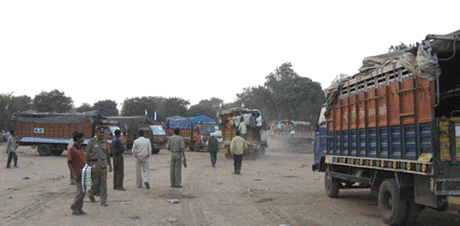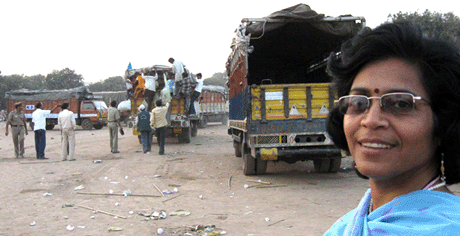Yet Ramlila Ground, a dusty, bald field that acted as Janadesh’s northern Delhi battlefield, illustrated a different story. Instead of a massive encampment of marchers and activists on an indefinite hunger strike, only a few flatbed trucks being loaded with a handful of jocund participants remained. Aside from them, only some local kids playing cricket and flying kites occupied the bedraggled turf.
"We’re going home," cheered 27-year-old Purushottam Rajput a social worker from Madhya Pradesh, one of India’s more rural provinces. "The government has met our demands. The people were so disciplined and there was no violence. Janadesh was such a success."
Engineered by Ekta Parishad, a non-profit inspired by Gandhian values of non-violence and civil disobedience, the organization seeks to create social change by ending the structural violence against the poor and marginalized. Janadesh, which from Hindi translates to ‘people’s verdict’, began on October 2nd (Gandhi’s birthday) in the central town of Gwalior. Ekta Parishad estimates that over 25,000 people descended upon Gwalior for the 350 km, 26 day trudge to New Delhi. The protesters sought for the government to commit itself to pro-poor land reform actions.

"My father and my entire family are poor, landless farmers," Rajput explained while stuffing his journey’s belongings into a stitched shoulder bag. "So I feel it’s my responsibility to fight for justice. I organized over 200 people from my district to participate in Janadesh. Now we are leaving to catch our trains back home to celebrate with our families," he said before hopping into one of the trucks that grumbled off towards the train station.
Similar to Rajput, most who participated in Janadesh were mainly low caste landless farmers, tribal people (adivasis), and their allies. To reach the chaotic capital of New Delhi, they had to march under the scorching sun and sleep in the brisk night winds. Food and water were organized ahead of time, as were access to toilets. Yet, for such a redoubtable march, it was not without problems. Seven people died during the long haul from Gwalior – four when an overturned truck struck them and three from exhaustion.
It’s this kind of dogged commitment from the 25,000 participants that underlines a fact often lost behind figures of India’s soaring GDP: that India is still a predominately agrarian society. Though charting astronomic economic gains as the world’s second fastest growing economy, 70% of the population still lives in poverty-strangled rural villages, 33% are illiterate, and few have access to adequate healthcare services.
Moreover, as India has impulsively industrialized, especially over the past 20 years, many farmers and indigenous tribal people have been drummed off their land in the name of development. Water dams, factories, and urbanization are just a few of the causes for these evictions.
Tribals in particular face a precarious situation. Though their families have lived in untouched forests for generations, wholly detached from Indian society, they lack any written deeds to their ancestral lands.

Archana Rathore, who by my estimate was the last participant at Ramlila Ground, seemed surprisingly put together after more than 26 days of camping beside the national highway. Her blue sari looked crisp, her makeup fresh, and her black coffee colored hair sculpted.
"I’m tired, but my feet are OK," she judged after glimpsing at her knobby, dirt-caked toes. She works with Perhit Sarjan Jan Ralyan Samitee, an NGO committed to improving the welfare of tribal people in Madhya Pradesh.
"Adivasis (tribals) lack healthcare, education, and land," she said, her bangles rattling as she hammered her fist for emphasis. "We especially want titles to our land so we can have some sense of security. People can barely eat and if they had land they could at least grow wheat and rice."
The current administration, led by Prime Minister Manmohan Singh, has officially met the movement’s requests.
On October 29th, as the marchers strapped in for a showdown with the authorities, the Minister of Rural Development, who had addressed the Janadesh protesters a few days before their arrival in Delhi, rushed to Ramlila Ground to break news of the government’s capitulation.
According to Ekta Parishad, a ‘National Land Reform Committee’ will be set up within one month. Ekta Prashad will then draft a land reform policy which the new committee will have the mandate to implement. Also, the government has promised to create a quick court system and one window policy to slash the bloated bureaucracy the people must struggle with just to have their land disputes heard and solved. Lastly, half of the committee members will be from social and civil organizations that Ekta Parishad will select.
Still, in India, a country where promises of these sorts float from the lips of bureaucrats like smoke from a tobacco bidi, the future remains uncertain. The creation of the National Land Reform Committee, though a powerful step in the right direction, will not be the panacea for the landless people of the subcontinent. To finally end structural rural poverty, the government must enact pro-poor legislation, and actually redistribute land. Without their own plots, farmers and tribal people will always smolder at the bottom of the social ladder, lacking even the most basic needs like food and dignity.
"We can’t really trust the government," shrugs Rathore before catching a ride to visit her family who lives in New Delhi. "We can only trust in God."
